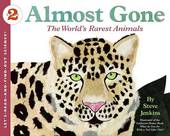
|
Almost Gone: The World's Rarest Animals
Paperback / softback
Main Details
| Title |
Almost Gone: The World's Rarest Animals
|
| Authors and Contributors |
By (author) Steve Jenkins
|
|
Illustrated by Steve Jenkins
|
| Series | Lets-Read-and-Find-Out Science Stage 2 |
|---|
| Physical Properties |
| Format:Paperback / softback | | Pages:40 | | Dimensions(mm): Height 222,Width 279 |
|
| ISBN/Barcode |
9780060536008
|
| Classifications | Dewey:591.68 |
|---|
| Audience | | General | | Children's (6-12) | |
|---|
|
Publishing Details |
| Publisher |
HarperCollins Publishers Inc
|
| Imprint |
HarperCollins
|
| Publication Date |
19 September 2007 |
| Publication Country |
United States
|
Description
Read and find out about endangered animals in this colorfully illustrated nonfiction picture book. Have you seen a northern hairy-nosed wombat or an eastern barred bandicoot These animals are so rare, they might disappear forever, and they're not alone. Read and find out about some of the animals that are almost gone. With gorgeous art from Caldecott Honor-winning artist Steve Jenkins, "this engaging title is informative as well as visually stunning." (School Library Journal starred review) This is a clear and appealing science book for early elementary age kids, both at home and in the classroom. It's a Level 2 Let's-Read-and-Find-Out, which means the book explores more challenging concepts for children in the primary grades. The 100+ titles in this leading nonfiction series are: hands-on and visual acclaimed and trusted great for classrooms Top 10 reasons to love LRFOs: Entertain and educate at the same time Have appealing, child-centered topics Developmentally appropriate for emerging readers Focused; answering questions instead of using survey approach Employ engaging picture book quality illustrations Use simple charts and graphics to improve visual literacy skills Feature hands-on activities to engage young scientists Meet national science education standards Written/illustrated by award-winning authors/illustrators & vetted by an expert in the field Over 130 titles in print, meeting a wide range of kids' scientific interests Books in this series support the Common Core Learning Standards, Next Generation Science Standards, and the Science, Technology, Engineering, and Math (STEM) standards. Let's-Read-and-Find-Out is the winner of the American Association for the Advancement of Science/Subaru Science Books & Films Prize for Outstanding Science Series.
Author Biography
Steve Jenkins has illustrated many children"s books, including What Do You Do with a Tail Like This, a Caldecott Honor Book, and The Top of the World: Climbing Mount Everest, winner of the Boston Globe-Horn Book Award. He has also illustrated Wiggling Worms at Work, Life in a Coral Reef, and Almost Gone in the Let"s-Read-and-Find-Out Science series. He lives in Boulder, Colorado.
Reviews"This engaging title is informative as well as visually stunning. Jenkins captures the essence of his subjects with appropriately colored, cut-paper collage illustrations on stark white backgrounds. Each endangered animal is introduced in a single paragraph that typically contains a fact or two about its range, behavior, diet, and those conditions that threaten its welfare. A middle section, 'Gone Forever,' memorializes animals no longer on Earth with an indication of when they were last seen. In a hopeful third section, Jenkins discusses three animals that are 'coming back,' due to the efforts to protect their habitats." - School Library Journal (starred review) "Caldecott Honor Book illustrator Jenkins applies his considerable talents to the cause of conservation. Using his signature cut-and torn-paper collages, he shows 21 endangered species, accompanying each image with a few sentences about the animal's habitatt, a particular characteristic, and, sometimes, the reason for its endangered status. As usual, Jenkins' artwork is fascinating. The last spreads consider four extinct animals and three species brought back from the brink by breeding or protection programs. A map designating the range of each species concludes this nicely accomplished entry in a generally stellar series." - Booklist
|